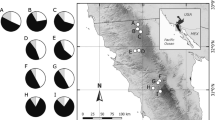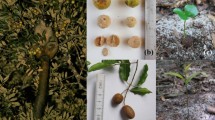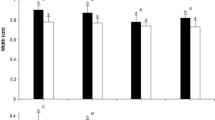Abstract
Fleshy fruits are used by various animals, including legitimate seed dispersers and fruit and seed predators. To clarify the overall effect of these plant-animal interactions on the annual fruit production and seed dispersal pattern of fleshy-fruited species, we investigated the demographic processes from flowering to fruit removal and their effect on seed dispersal of Photinia glabra, which shows variable seed dispersal and has a specialized insect seed predator, Argyresthia assimilis, tightly dependent on its fruit. We sorted all reproductive organs for ten trees from 2013 to 2021 on Takaragaike Hill in northern Kyoto City, western Japan (35° 3′N, 135° 46′E; 110–150 m above mean sea level). The amplitude of intra-individual variability (\(\overline{{CV }_{i}}\) value of 0.97) and inter-individual synchrony (\(\overline{{r }_{p}}\) value of 0.30) in flower production was relatively weak, which would not fully contribute to the reduction in fruits damaged by A. assimilis. Compared with flower production, we observed highly variable (\(\overline{{CV }_{i}}\) value of 1.39) and synchronous (\(\overline{{r }_{p}}\) value of 0.89) seed dispersal by legitimate seed dispersers within individuals. Reproductive loss due to generalist avian seed predators was the most prominent factor contributing to annual variability in total pre-dispersal losses, followed by losses due to A. assimilis. Annual variability in the visitation frequency of avian seed predators, especially migratory Fringilla montifringilla, may affect the amount of ripened fruit available to legitimate seed dispersers. We suggest that the effect of damage due to generalist seed predators directly determines the intermittent and highly synchronous seed dispersal of P. glabra.





Similar content being viewed by others
Data availability
The authors confirm that the data supporting the findings of this study are available within the article and its supplementary materials.
References
Araki N, Hirayama K (2020) Differences in the fruit removal patterns of Cleyera japonica by frugivorous birds in two forest stands at different developmental stages in a warm-temperate region. Ecol Res 36:189–201. https://doi.org/10.1111/1440-1703.12188
Bogdziewicz M, Szymkowiak J, Tanentzap AJ, Calama R, Marino S, Steele MA, Seget B, Piechnik L, Zywiec M (2021) Seed predation selects for reproductive variability and synchrony in perennial plants. New Phytol 229:2357–2364. https://doi.org/10.1111/nph.16835
Connell JH (1971) On the role of natural enemies in preventing competitive exclusion in some marine animals and in rain forest trees. In: Den Boer PJ, Gradwell GR (eds) Dynamics of populations. Centre for Agricultural Publishing and Documentation, Wageningen, The Netherlands, pp 298–312
Debussche M, Isenmann P (1989) Fleshy fruit characters and the choices of bird and mammal seed dispersers in a Mediterranean region. Oikos 56:327–338. https://doi.org/10.2307/3565617
Eriksson O (2016) Evolution of angiosperm seed disperser mutualisms: the timing of origins and their consequences for coevolutionary interactions between angiosperms and frugivores. Biol Rev 91:168–186. https://doi.org/10.1111/brv.12164
Fletcher QE, Boutin S, Lane JE, LaMontagne JM, McAdam AG, Krebs CJ, Humphries MM (2010) The functional response of a hoarding seed predator to mast seeding. Ecology 91:2673–2683. https://doi.org/10.1890/09-1816.1
Herrera CM (1986) Vertebrate-dispersed plants: why they don’t behave the way they should. In: Estrada A, Fleming TH (eds) Frugivores and seed dispersal. Dr W Junk Publishers, Dordrecht, The Netherlands, pp 5–18
Herrera CM (2002) Seed dispersal by vertebrates. In: Herrera CM, Pellmyr O (eds) Plant-animal interactions: an evolutionary approach. Blackwell Science, Oxford, England, pp 185–208
Herrera CM, Jordano P, Guitian J, Traveset A (1998) Annual variability in seed production by woody plants and the masting concept: reassessment of principles and relationship to pollination and seed dispersal. Am Nat 152:576–594. https://doi.org/10.1086/286191
Hirayama K, Sasaki M, Ohshima I (2018) First host record of Argyresthia assimilis Moriuti, 1977 (Lepidoptera: Yponomeutidae) and a description of its annual life history. Lepid Sci 69:99–106. https://doi.org/10.18984/lepid.69.3-4_99
Hirayama K, Yamada K, Nishimura T, Kawamura S, Takahara H (2011) Changes in species composition and diversity with respect to the successional stage of urban forests in Kyoto city, western Japan. J Jpn For Soc 93:21–28. https://doi.org/10.4005/jjfs.93.21. (in Japanese with English summary)
Hirayama K, Yamada S, Machida H, Yoshikawa T (2016) How do changes in forest stand development affect frugivorous bird abundance and fruit removal in warm-temperate forests of western Japan? Plant Ecol 217:1081–1094. https://doi.org/10.1007/s11258-016-0634-5
Hirayama K, Mizo K, Tatsuno M, Yoshikawa M, Tachikawa C (2022) Annual variability in the sound acorn production of Quercus serrata is regulated by a seed-predatory weevil in western Japan. Ecol Res 37:711–721. https://doi.org/10.1111/1440-1703.12339
Holling CS (1959) The components of predation as revealed by a study of small-mammal predation of the European pine sawfly. Can Entomol 91:293–320. https://doi.org/10.4039/Ent91293-5
Ikeda H, Iketani Y, Katsuki T (2016) Rosaceae. In: Oba H, Kadota Y, Murata J, Yonekura K, Kihara H (eds) Wild flowers of Japan, vol 3. Heibonsha, Tokyo, Japan, pp 23–88 ((in Japanese))
Ims RA (1990) The ecology and evolution of reproductive synchrony. Trends Ecol Evol 5:135–140. https://doi.org/10.1016/0169-5347(90)90218-3
Janzen DH (1970) Herbivores and the number of tree species in tropical forests. Am Nat 104:501–528. https://doi.org/10.1086/282687
Jordano P (1987) Avian fruit removal: effects of fruit variation, crop size, and insect damage. Ecology 68:1711–1723. https://doi.org/10.2307/1939863
Jordano P (1989) Pre-dispersal biology of Pistacia lentiscus (Anacardiaceae): cumulative effects on seed removal by birds. Oikos 55:375–386. https://doi.org/10.2307/3565598
Jordano P (1994) Spatial and temporal variation in the avian-frugivore assemblage of Prunus mahaleb: patterns and consequences. Oikos 71:479–491. https://doi.org/10.2307/3545836
Jordano P, Schupp EW (2000) Seed disperser effectiveness: the quantity component and patterns of seed rain for Prunus mahaleb. Ecol Monogr 70:591–615. https://doi.org/10.1890/0012-9615(2000)070[0591:Sdetqc]2.0.Co;2
Kelly D, Sullivan JJ (1997) Quantifying the benefits of mast seeding on predator satiation and wind pollination in Chionochloa pallens (Poaceae). Oikos 78:143–150. https://doi.org/10.2307/3545810
Kobro S, Søreide L, Djønne E, Rafoss T, Jaastad G, Witzgall P (2003) Masting of rowan Sorbus aucuparia L. and consequences for the apple fruit moth Argyresthia conjugella Zeller. Popul Ecol 45:25–30. https://doi.org/10.1007/s10144-003-0136-x
Koenig WD, Kelly D, Sork VL, Duncan RP, Elkinton JS, Peltonen MS, Westfall RD (2003) Dissecting components of population-level variation in seed production and the evolution of masting behavior. Oikos 102:581–591. https://doi.org/10.1034/j.1600-0706.2003.12272.x
Kuge A, Hirayama K (2017) Aggregated recruitment patterns under adult crowns in Photinia glabra, a bird-dispersed tree species. Plant Species Biol 32:348–358. https://doi.org/10.1111/1442-1984.12166
Linhart YB, Moreira X, Snyder MA, Mooney KA, Carson W (2014) Variability in seed cone production and functional response of seed predators to seed cone availability: support for the predator satiation hypothesis. J Ecol 102:576–583. https://doi.org/10.1111/1365-2745.12231
Moreira X, Pérez-Ramos IM, Abdala-Roberts L, Mooney KA (2017) Functional responses of contrasting seed predator guilds to masting in two Mediterranean oak species. Oikos 126:1042–1050. https://doi.org/10.1111/oik.03722
Nevo O, Razafimandimby D, Valenta K, Jeffrey JAJ, Reisdorff C, Chapman CA, Ganzhorn JU, Ayasse M (2019) Signal and reward in wild fleshy fruits: does fruit scent predict nutrient content? Ecol Evol 9:10534–10543. https://doi.org/10.1002/ece3.5573
Noma N (1997) Annual fluctuations of sapfruits production and synchroniation within and inter species in a warm temperate forest on Yakushima Island. Tropics 6:441–449
Pascoe BA, Pavey CR, Morton SR, Schlesinger CA (2021) Dynamics of bird assemblages in response to temporally and spatially variable resources in arid Australia. Ecol Evol 11:3977–3990. https://doi.org/10.1002/ece3.7293
Podoler H, Rogers D (1975) A new method for the identification of key factors from life-table data. J Anim Ecol 44:85–114. https://doi.org/10.2307/3853
R Core team (2021) R: a language and environment for statistical computing. R Foundation for statistical computing, Vienna, Austria. https://www.R-project.org/
Satake A, N. Bjørnstad O, Kobro S, (2004) Masting and trophic cascades: interplay between rowan trees, apple fruit moth, and their parasitoid in southern Norway. Oikos 104:540–550. https://doi.org/10.1111/j.0030-1299.2004.12694.x
Shibata M, Tanaka H, Iida S, Abe S, Masaki T, Niiyama K, Nakashizuka T (2002) Synchronized annual seed production by 16 principal tree species in a temperate deciduous forest, Japan. Ecology 83:1727–1742. https://doi.org/10.1890/0012-9658(2002)083[1727:Saspbp]2.0.Co;2
Silvertown JW (1980) The evolutionary ecology of mast seeding in trees. Biol J Linn Soc 14:235–250. https://doi.org/10.1111/j.1095-8312.1980.tb00107.x
Soler R, Espelta JM, Lencinas MV, Peri PL, Martínez Pastur G (2017) Masting has different effects on seed predation by insects and birds in antarctic beech forests with no influence of forest management. Forest Ecol Manag 400:173–180. https://doi.org/10.1016/j.foreco.2017.06.014
Sperens U (1997) Fruit production in Sorbus aucuparia L. (Rosaceae) and pre-dispersal seed predation by the apple fruit moth (Argyresthia conjugella Zell.). Oecologia 110:368–373. https://doi.org/10.1007/s004420050171
Traveset A (1994) Cumulative effects on the reproductive output of Pistacia terebinthus (Anacardiaceae). Oikos 71:52–162. https://doi.org/10.2307/3546182
Tsunamoto Y, Naoe S, Masaki T, Isagi Y (2020) Different contributions of birds and mammals to seed dispersal of a fleshy-fruited tree. Basic Appl Ecol 43:66–75. https://doi.org/10.1016/j.baae.2019.07.005
Yoshikawa T, Isagi Y, Kikuzawa K (2009) Relationships between bird-dispersed plants and avian fruit consumers with different feeding strategies in Japan. Ecol Res 24:1301–1311. https://doi.org/10.1007/s11284-009-0612-7
Żywiec M, Holeksa J, Ledwoń M (2012) Population and individual level of masting in a fleshy-fruited tree. Plant Ecol 213:993–1002. https://doi.org/10.1007/s11258-012-0059-8
Żywiec M, Ledwoń M, Holeksa J, Seget P, Łopata B, Fedriani JM, Zhou S (2018) Rare events of massive plant reproductive investment lead to long-term density-dependent reproductive success. J Ecol 106:1307–1318. https://doi.org/10.1111/1365-2745.12896
Acknowledgements
We thank the staff of the Midori-Seisaku-Suishin Office of Kyoto City for their permission to use the forest for our study. We also thank the members of the laboratory for research assistance and Akihiro Sumida for statistical analyses. This study was partially supported by JSPS KAKENHI (Grant Number 24780154), and the Research Assistant System provided by the Committee for the Promotion of Gender Equality in Kyoto Prefectural University.
Funding
This study was partially supported by JSPS KAKENHI (Grant Number 24780154).
Author information
Authors and Affiliations
Contributions
KH conceived the ideas and designed methodology; AM, SK, AT, MS and AK collected the data; KH analyzed the data and wrote the manuscript. All authors contributed the drafts and gave final approval for publication.
Corresponding author
Ethics declarations
Conflict of interest
The authors declare no conflicts of interest.
Additional information
Communicated by Jaime Moyano (mjaime@agro.uba.ar).
Publisher's Note
Springer Nature remains neutral with regard to jurisdictional claims in published maps and institutional affiliations.
Supplementary Information
Below is the link to the electronic supplementary material.
Rights and permissions
Springer Nature or its licensor (e.g. a society or other partner) holds exclusive rights to this article under a publishing agreement with the author(s) or other rightsholder(s); author self-archiving of the accepted manuscript version of this article is solely governed by the terms of such publishing agreement and applicable law.
About this article
Cite this article
Hirayama, K., Masuda, A., Kurokawa, S. et al. How do specialist and generalist seed predators affect the highly variable and synchronized seed dispersal of Photinia glabra (Rosaceae), a fleshy-fruited tree?. Plant Ecol 224, 189–201 (2023). https://doi.org/10.1007/s11258-023-01289-2
Received:
Accepted:
Published:
Issue Date:
DOI: https://doi.org/10.1007/s11258-023-01289-2




